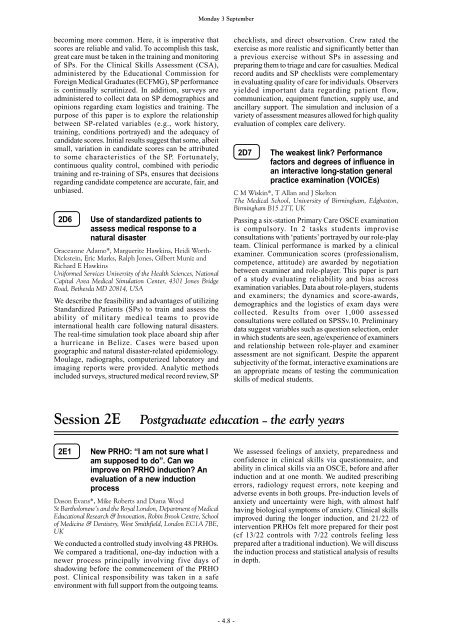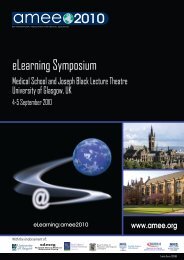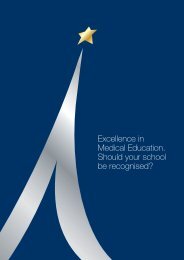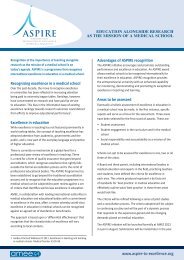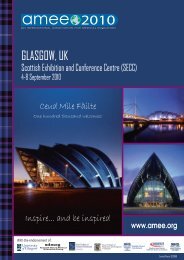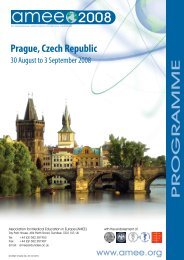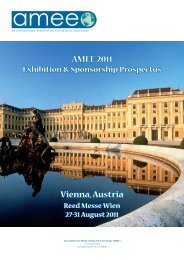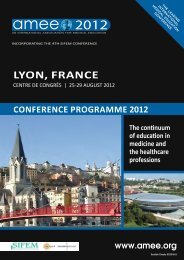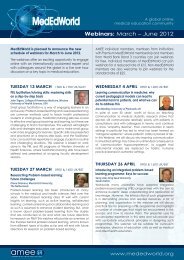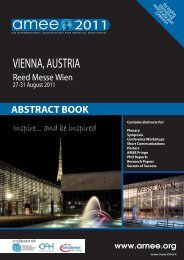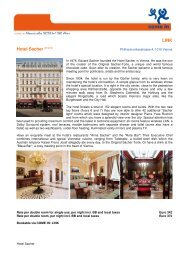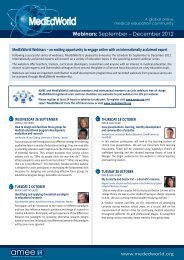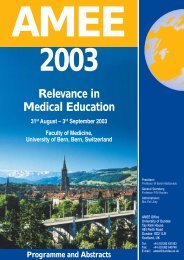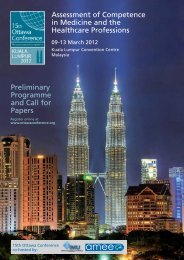AMEE Berlin 2002 Programme
AMEE Berlin 2002 Programme
AMEE Berlin 2002 Programme
You also want an ePaper? Increase the reach of your titles
YUMPU automatically turns print PDFs into web optimized ePapers that Google loves.
ecoming more common. Here, it is imperative that<br />
scores are reliable and valid. To accomplish this task,<br />
great care must be taken in the training and monitoring<br />
of SPs. For the Clinical Skills Assessment (CSA),<br />
administered by the Educational Commission for<br />
Foreign Medical Graduates (ECFMG), SP performance<br />
is continually scrutinized. In addition, surveys are<br />
administered to collect data on SP demographics and<br />
opinions regarding exam logistics and training. The<br />
purpose of this paper is to explore the relationship<br />
between SP-related variables (e.g., work history,<br />
training, conditions portrayed) and the adequacy of<br />
candidate scores. Initial results suggest that some, albeit<br />
small, variation in candidate scores can be attributed<br />
to some characteristics of the SP. Fortunately,<br />
continuous quality control, combined with periodic<br />
training and re-training of SPs, ensures that decisions<br />
regarding candidate competence are accurate, fair, and<br />
unbiased.<br />
2D6 Use of standardized patients to<br />
assess medical response to a<br />
natural disaster<br />
Graceanne Adamo*, Marguerite Hawkins, Heidi Worth-<br />
Dickstein, Eric Marks, Ralph Jones, Gilbert Muniz and<br />
Richard E Hawkins<br />
Uniformed Services University of the Health Sciences, National<br />
Capital Area Medical Simulation Center, 4301 Jones Bridge<br />
Road, Bethesda MD 20814, USA<br />
We describe the feasibility and advantages of utilizing<br />
Standardized Patients (SPs) to train and assess the<br />
ability of military medical teams to provide<br />
international health care following natural disasters.<br />
The real-time simulation took place aboard ship after<br />
a hurricane in Belize. Cases were based upon<br />
geographic and natural disaster-related epidemiology.<br />
Moulage, radiographs, computerized laboratory and<br />
imaging reports were provided. Analytic methods<br />
included surveys, structured medical record review, SP<br />
- 4.8 -<br />
checklists, and direct observation. Crew rated the<br />
exercise as more realistic and significantly better than<br />
a previous exercise without SPs in assessing and<br />
preparing them to triage and care for casualties. Medical<br />
record audits and SP checklists were complementary<br />
in evaluating quality of care for individuals. Observers<br />
yielded important data regarding patient flow,<br />
communication, equipment function, supply use, and<br />
ancillary support. The simulation and inclusion of a<br />
variety of assessment measures allowed for high quality<br />
evaluation of complex care delivery.<br />
2D7 The weakest link? Performance<br />
factors and degrees of influence in<br />
an interactive long-station general<br />
practice examination (VOICEs)<br />
C M Wiskin*, T Allan and J Skelton<br />
The Medical School, University of Birmingham, Edgbaston,<br />
Birmingham B15 2TT, UK<br />
Passing a six-station Primary Care OSCE examination<br />
is compulsory. In 2 tasks students improvise<br />
consultations with ‘patients’ portrayed by our role-play<br />
team. Clinical performance is marked by a clinical<br />
examiner. Communication scores (professionalism,<br />
competence, attitude) are awarded by negotiation<br />
between examiner and role-player. This paper is part<br />
of a study evaluating reliability and bias across<br />
examination variables. Data about role-players, students<br />
and examiners; the dynamics and score-awards,<br />
demographics and the logistics of exam days were<br />
collected. Results from over 1,000 assessed<br />
consultations were collated on SPSSv.10. Preliminary<br />
data suggest variables such as question selection, order<br />
in which students are seen, age/experience of examiners<br />
and relationship between role-player and examiner<br />
assessment are not significant. Despite the apparent<br />
subjectivity of the format, interactive examinations are<br />
an appropriate means of testing the communication<br />
skills of medical students.<br />
Session 2E Postgraduate education – the early years<br />
2E1 New PRHO: “I am not sure what I<br />
am supposed to do”. Can we<br />
improve on PRHO induction? An<br />
evaluation of a new induction<br />
process<br />
Dason Evans*, Mike Roberts and Diana Wood<br />
St Bartholomew’s and the Royal London, Department of Medical<br />
Educational Research & Innovation, Robin Brook Centre, School<br />
of Medicine & Dentistry, West Smithfield, London EC1A 7BE,<br />
UK<br />
We conducted a controlled study involving 48 PRHOs.<br />
We compared a traditional, one-day induction with a<br />
newer process principally involving five days of<br />
shadowing before the commencement of the PRHO<br />
post. Clinical responsibility was taken in a safe<br />
environment with full support from the outgoing teams.<br />
Monday 3 September<br />
We assessed feelings of anxiety, preparedness and<br />
confidence in clinical skills via questionnaire, and<br />
ability in clinical skills via an OSCE, before and after<br />
induction and at one month. We audited prescribing<br />
errors, radiology request errors, note keeping and<br />
adverse events in both groups. Pre-induction levels of<br />
anxiety and uncertainty were high, with almost half<br />
having biological symptoms of anxiety. Clinical skills<br />
improved during the longer induction, and 21/22 of<br />
intervention PRHOs felt more prepared for their post<br />
(cf 13/22 controls with 7/22 controls feeling less<br />
prepared after a traditional induction). We will discuss<br />
the induction process and statistical analysis of results<br />
in depth.


